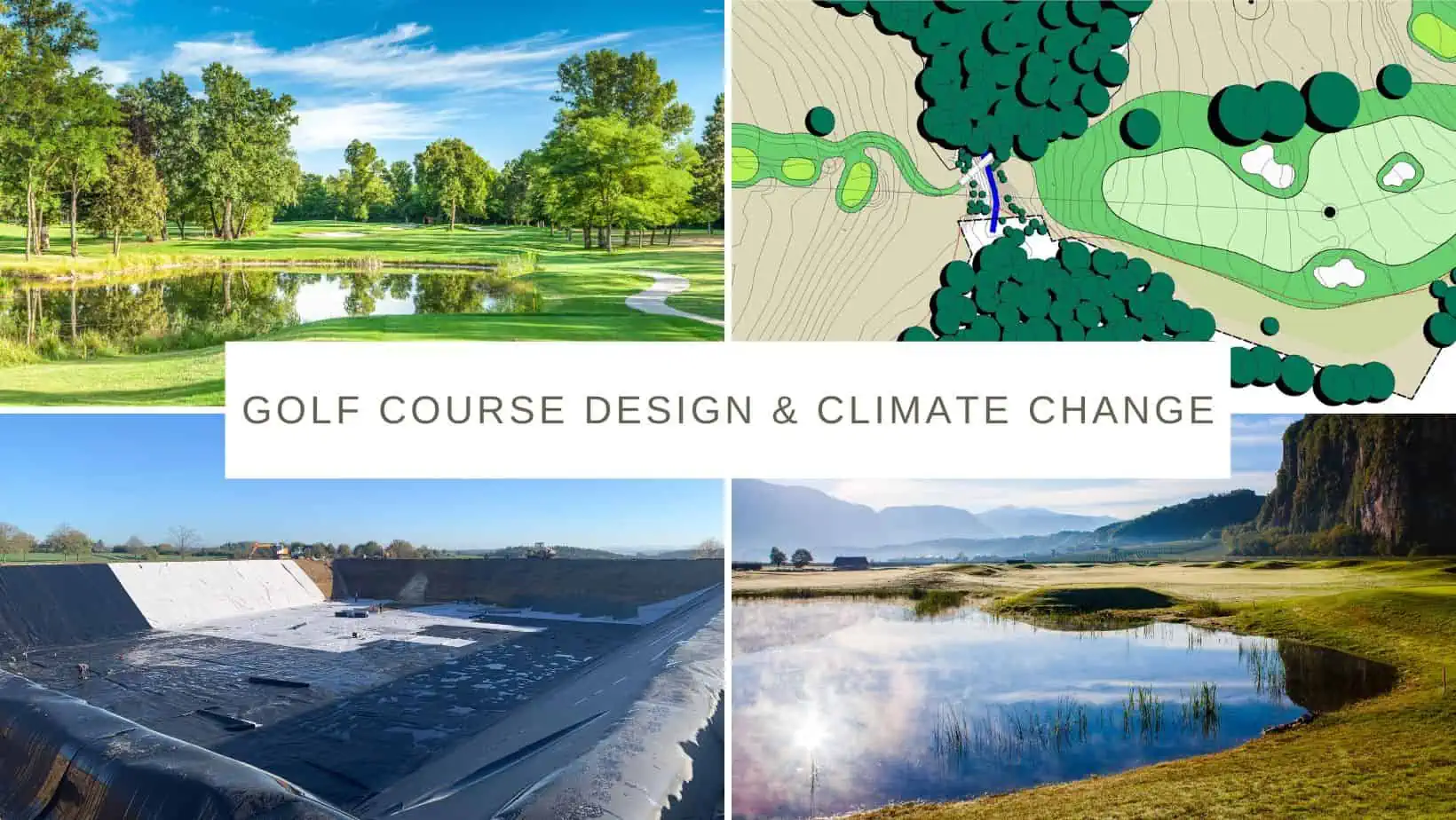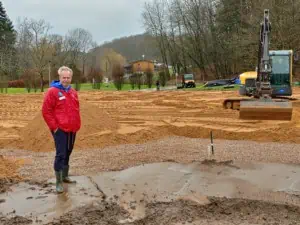Increase resilience to extreme weather with golf course design
Change means new opportunities: This also applies to the topic of “climate change and golf course architecture”, which is currently affecting many golf courses internationally. The multitude of issues that affect golf facility operators and golf course designers alike in the process is undoubtedly challenging. For Thomas Himmel, as a golf course designer responsible for the construction and renovation of numerous golf courses in Europe, the following topics are essential:
- Drought and water reductions: How do we design golf courses to use as little water as possible while also providing ideal capture and storage? What grass species do we use to seed or reseed fairways and greens to support these processes?
- Extreme precipitation: How do we achieve first-class drainage, as little erosion as possible, and high follow-up costs for bunkers or paths, for example, through the right design?
- Energy savings and Co2 footprint: The larger the areas to be mowed, raked, fertilized or irrigated, the higher the consumption of energy and the more abundant the CO₂ footprint.
- Cost increase: Whether prices for sand, sprinklers or pipes. Cost increases result in the need to adjust budgets for renovations and new construction. How can this be addressed through customized design?
- Human resource: The labour shortage in the golf course sector remains a problem, especially since the effects of climate change often mean additional work, particularly in the area of extreme weather. How can a combination of fewer labour hours while maintaining quality be achieved?
Numerous developments in the field of golf course design are encouraging in this regard – a sustainable and resilient golf course will definitely look different from a top golf course 20 years ago, but it does not necessarily have to lose quality and attractiveness.
Finesse instead of length
The topic of golf course length plays a prominent role. Studies by the R&A and USGA show that the bulk of golf courses of the future will deviate from the current trend toward ever-longer courses because ever-increasing acreage will break the bank on water, fertilizer and labour costs. More finesse in greens, interesting green surrounds, and strategically placed individual hazards such as trees can easily provide an equal or even greater challenge, but are significantly more resource efficient.
Area reduction
Reducing land area is also one of the approaches to intelligent water management, which is made up of several factors. After a detailed analysis of the local conditions and the expected precipitation situation in the future, supplemented by the expected stricter regulation of groundwater and a move away from the use of potable water for irrigation, water management must be set up individually for each course. Taking out mowing and sprinkling areas around tees, for example, makes for better visuals, especially in dry periods. Even in zones away from play, this achieves water savings and a reduced workload while maintaining an attractive appearance with different grasses or meadows.
Notspeicher für Dürrephasen
Auf den meisten Golfanlagen bietet sich die Anlage von Zwischen- oder Notspeichern an, in denen größere Mengen Wasser für Dürrephasen bevorratet werden. Speicherteiche von mehr als 100.000 m³ Wasser werden inzwischen in Kontinentaleuropa gebaut. Diese können sowohl als optisch weniger attraktive technische Speicher außerhalb der klassischen Spielfläche so angelegt werden, dass sie aufgrund großer Tiefe wenig Verdunstungsfläche haben, andererseits aber auch als ins Spiel integrierte Speicherflächen gestaltet werden. Hier kommt dann außerdem die Vernetzung von mehreren kleineren Teichen infrage, wenn sich ein extrem großer Notfallspeicher optisch und strategisch nicht gut einbinden lässt.
Brauchwasser schafft Unabhängigkeit
Daneben spielt bei der Neugestaltung von Golfplätzen die Einbindung von Klär- oder Brauchwasser eine immer größere Rolle. Die Nutzung von Brauchwasser aus Wohngebieten, die Wiederaufbereitung von Drainage- und Brauchwasser der eigenen Golfanlage und die Anbindung an Klärwasser erfordert zwar oftmals höhere Anfangsinvestitionen in Technik und ist von der Lage des Golfplatzes abhängig, sorgt aber für Unabhängigkeit bei der Wasserversorgung. Das richtige Golfplatzdesign sorgt hier von Beginn an dafür, dass Drainagewasser auch von Parkplätzen sowie Regenwasser von Dächern optimal eingebunden wird.
Design adjustments in flood zones
At the same time, golf courses of the future also have a role to play in flooding concepts. Golf courses are definitely used in part as floodplains for smaller rivers and streams. As a result, however, the design of holes must be such that elevated greens and tees, proper fairway design, or inconspicuous small dams minimize damage to the golf course in the event of flooding.
Thinking about heavy rain for bunkers
Especially when it comes to heavy rain and flooding, the bunker design of golf courses is becoming more and more of an issue. The design of bunkers, as well as their size and number, is particularly relevant to sustainable places. Investing in stabilization layers in the bunker to prevent gravel and sand from mixing and drainage from clogging is costly, but it facilitates playability and prevents major erosion damage, especially in areas that are increasingly affected by particularly severe storms.
Reducing the size of bunkers is also becoming an issue on more and more golf course surfaces, and here it is the role of the golf course designer to find an interesting alternative, both visually and in terms of play, for bunkers. Both are possible, however, so expensive bunker renovations are not the only way to deal with severe weather.
Intelligent path construction
Especially in the area of the bunkers, the club and greenkeeper side also puts forward the argument of the working hours. Increasing heavy rainfall in many cases at golf courses is causing greenkeepers to need increased time to restore, this incidentally also applies to paths. Therefore, even when creating or renovating paths or bunkers, it is important to ensure that they are created in such a way that their design, structure or the materials used are not particularly susceptible to erosion.
The golfer himself does not have to perceive all these changes to a golf course negatively at all. Quite the opposite: well laid out meadows and rough areas can make a course much more visually attractive than mown-through areas, which often look unpleasantly uniform brown when water is scarce. Storage ponds can serve as playful obstacles as well as eye-catchers through the appropriate planting. Finally, shorter golf courses are not automatically easy and uninteresting if they are enhanced by interesting greens or green surrounds.
Establish resilience of golf facilities
So the effects of climate change, as unpleasant as they currently are for each individual golf facility, are not automatically associated only with negative consequences. Rather, the goal is to critically analyse the existing design of the golf facility and examine the resilience of the facility and its future viability. An adjustment can then be made in individual steps and at the same time be combined with an improvement of existing design weaknesses. An attractive golf course that is less susceptible to weather extremes and less resource-intensive (and therefore less costly) to maintain is a positive goal that the membership will be happy to join.











